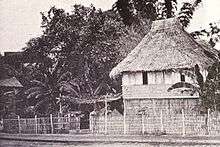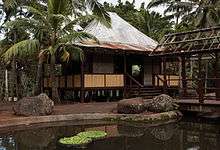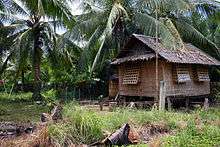Nipa hut

The Nipa hut, Kamalig, or Bahay Kubo, is a type of stilt house indigenous to the vast majority of lowland Austronesian cultures of the Philippines.[1][2] It often serves as an icon of Philippine culture or more specifically, Filipino rural culture.[3]
Etymology
The Filipino term Bahay Kubo literally means "cube house", describing the shape of the dwelling. The term "Nipa Hut", introduced during the Philippines' American colonial era, refers to the nipa or anahaw thatching material often used for the roofs.
History

Classical Period (precolonial Era)
Nipa huts were the native houses of the indigenous people of the Philippines before the Spaniards arrived. They are still used today, especially in rural areas. Different architectural designs are present among the different ethnolinguistic groups in the country, although all of them conform to being stilt houses, similar to those found in neighboring countries such as Indonesia, Malaysia, and other countries of Southeast Asia.
Colonial Era
The advent of the Spanish Colonial era introduced the idea of building more permanent communities with the Church and Government Center as a focal point. This new community setup made construction using heavier, more permanent materials desirable. Finding European construction styles impractical given local conditions, both Spanish and Filipino builders quickly adapted the characteristics of the Bahay Kubo and applied it to Antillean houses locally known as Bahay na Bato kaihti kili
Characteristics

Although there is no strict definition of the Bahay Kubo and styles of construction vary throughout the Philippine archipelago,[4] similar conditions in Philippine lowland areas have led to numerous characteristics "typical" of examples of Bahay Kubo.
Three-layered structure

With few exceptions arising only in modern times, most Bahay Kubo are raised on stilts such that the living area has to be accessed through ladders. This naturally divides the bahay kubo into three areas: the actual living area in the middle, the area beneath it (referred to in Tagalog as the "Silong"), and the roof space ("Bubungan" in Tagalog), which may or may not be separated from the living area by a ceiling ("Kisame" in Tagalog).
Roof
The traditional roof shape of the Bahay Kubo is tall and steeply pitched, ending in long leaves.[2] A tall roof created space above the living area through which warm air could rise, giving the Bahay Kubo a natural cooling effect even during the hot summer season. The steep pitch allowed water to flow down quickly at the height of the monsoon season while the long eaves gave people a limited space to move about around the house's exterior whenever it rained.[2] The steep pitch of the roofs are often used to explain why many Bahay Kubo survived the ash fall from the Mt. Pinatubo eruption, when more ’modern’ houses notoriously collapsed from the weight of the ash.[2]
Silong
Raised up on hardwood stilts which serve as the main posts of the house, Bahay Kubo have a Silong (the Tagalog word also means "shadow") area under the living space for a number of reasons, the most important of which are to create a buffer area for rising waters during floods, and to prevent pests such as rats from getting up to the living area.[2] This section of the house is often used for storage, and sometimes for raising farm animals,[4] and thus may or may not be fenced off.
Living Space
The main living area of the Bahay Kubo is designed to let in as much fresh air and natural light as possible. Smaller Bahay Kubo will often have bamboo slat floors which allow cool air to flow into the living space from the silong below (in which case the Silong is not usually used for items which produce strong smells), and the particular Bahay Kubo may be built without a kisame (ceiling) so that hot air can rise straight into the large area just beneath the roof, and out through strategically placed vents there.
Walls

The walls are always of light material such as wood, bamboo rods, or bamboo mats called "sawali." As such, they tend to also let some coolness flow naturally through them during hot times, and keep warmth in during the cold wet season.
The cube shape distinctive of the Bahay Kubo arises from the fact that it is easiest to pre-build the walls and then attach them to the wooden stilt-posts that serve as the corners of the house. The construction of a Bahay Kubo is therefore usually modular, with the wooden stilts established first, a floor frame built next, then wall frames, and finally, the roof.
Windows
In addition, Bahay kubo are typically built with large windows, to let in more air and natural light. The most traditional are large awning windows, held open by a wooden rod).[2] Sliding windows are also common, made either with plain wood or with wooden Capiz shell frames which allow some light to enter the living area even with the windows closed. In more recent decades inexpensive jalousie windows also became commonly used.
In larger examples, the large upper windows may be augmented with smaller windows called Ventanillas (Spanish for "little window) underneath", which can be opened to let in additional air on especially hot days.[2]
Batalan
Some (but not all) Bahay Kubo, especially one built for long-term resicence, feature a Batalan "wet area" distinct from other sections of the house - usually jutting out somewhat from one of the walls. Sometimes at the same level as the living area and sometimes at ground level, the Batalan can contain any combination of cooking and dishwashing area, bathing area, and in some cases, a lavatory.
Construction Materials
The walls of the living area are made of light materials - with posts, walls, and floors typically made of wood or bamboo and other light materials. Topped by a thatched roof, often made out of nipa, anahaw or some other locally plentiful plant.
Cultural significance
A Nipa hut is an icon of Philippine culture as it represents the Filipino value of bayanihan, which refers to a spirit of communal unity or effort to achieve a particular objective.[3][5]
Arts
A famous folk song often sung in schools which mentions a small house surrounded by vegetables goes like this:
Bahay kubo, kahit munti,
ang halaman doon ay sari-sari:
singkamas at talong, sigarilyas at mani,
sitaw, bataw, patani,
Kundol, patola, upo't kalabasa,
At saka mayroon pang labanos, mustasa,
sibuyas, kamatis, bawang at luya.
Sa paligid-ligid ay puno ng linga.
[1]
- ^ "Bahay Kubo (Philippine Kids Song)". Mama Lisa's World. Retrieved 23 July 2015.
References
- ↑ Lee, Jonathan H. X.. Encyclopedia of Asian American folklore and folklife, Vol. 1. Santa Barbara, Calif.: ABC-CLIO, 2011. 369. ISBN 0313350663
- 1 2 3 4 5 6 7 Caruncho, Eric S. (2012-05-15). "Green by Design: Sustainable Living through Filipino Architecture". Philippine Daily Inquirer. Makati, Philippines: Philippine Daily Inquirer, Inc. Retrieved 2013-10-16.
- 1 2 Cruz, Rachelle (2013-08-23). "THE BAYANIHAN: Art Installation at Daniel Spectrum". The Philippine Reporter. Toronto, Ontario, Canada. Retrieved 2013-10-16.
- 1 2 Alojado, Jennibeth Montejo. "From Nipa Hut to House of Stone". philippine-islands.ph. Alojado Publishing International. Retrieved 2013-10-16.
- ↑ Werth, Brenda G.. Imagining human rights in twenty-first-century theater: global perspectives. Basingstoke: Palgrave Macmillan, 2013. 207. ISBN 1137027096
External links
| Wikimedia Commons has media related to Nipa huts. |

